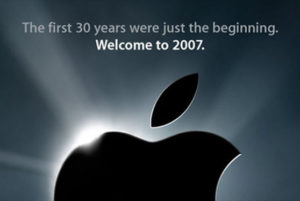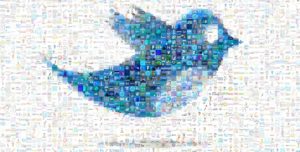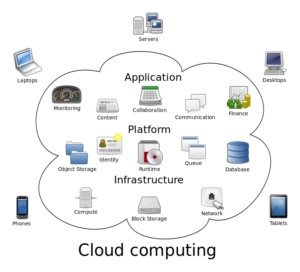Both really. 2007 was pivotal. A big year in our digital history. It was also the year “An Inconvenient Truth” won the Oscar for best documentary, and Al Gore told us we only had 10 years to save the planet. It was the year my literary hero Kurt Vonnegut died. The Police and the Spice Girls both did reunion tours. J. K. Rowling published the 7th and final novel in the Harry Potter series (she’s on a reunion tour of sorts herself 10 years on), but these aren’t the reasons 2007 was so important.
I started thinking about this a few weeks back, on 14th February, when I celebrated 10 years on Twitter, but I’m getting ahead of myself. We’ve been talking digital since Nicholas Negroponte’s Being Digital book in 1995, with a steady build up of the technologies and associated behaviours that have changed marketing and insinuated themselves in to general business use, changing things completely in the intervening 22 years. Here are 5 reasons, though, why 2007 stands out during that seismic shift.
The iPhone was announced (but it was a slow burn)
 Invitations to the Macworld event on 9th January 2007 suggested that the last 30 years had been just the beginning, and everything was about to change. Actually we only realised this was true and not Apple marketing hype several years later. At the now famous keynote, after more than half an hour of other announcements, Steve Jobs explained:
Invitations to the Macworld event on 9th January 2007 suggested that the last 30 years had been just the beginning, and everything was about to change. Actually we only realised this was true and not Apple marketing hype several years later. At the now famous keynote, after more than half an hour of other announcements, Steve Jobs explained:
“Well today, we’re introducing THREE revolutionary new products. The first one is a widescreen ipod with touch controls. The second is a revolutionary new mobile phone (the crowd went wild). And the third is a breakthrough internet communications device (they were less wild about that).”
And all 3 were the same device. But it was expensive. On top that we had to wait – it wasn’t going to be available until 29th June. It did, however, completely redefine the smart phone (and multi touch screen) user interface, but on initial announcement the iPhone was a closed device. It was only available on one US network, Cingular, and only available with a small collection of native apps. Steve told people that Apple and Cingular needed it to be that way because:
“You don’t want your phone to be an open platform. You don’t want it to not work because one of three apps you loaded that morning screwed it up” and “Cingular doesn’t want to see their West Coast network go down because of some app”.
Where would we be now if Steve had stuck with that position? Actually and thankfully, things had all changed before the end of 2007, but you also need to be reminded of the rest of the smart phone landscape of the time. The major smart phone players were Nokia, Motorola, Sony and BlackBerry (where are they all now?). The Nokia smart phone market share high point was in Q4 of 2007 at 50.9%! Personally, this was the year I upgraded from a Blackberry 8700 to a Blackberry Curve. At the time I considered the Nokia E61i, but not the iPhone. I tried the soft keyboard and just couldn’t get on with it. Actually, one of the coolest phones to own in 2007 was the Nokia n95 which, at the time, was the most powerful smart phone (with apps) you could buy as well as being a satnav, a camera, a player of music, and it was a phone too. If you look at the market share statistics going forward many of us continued to buy non Apple smart phones well in to 2009.
What made the iPhone a real game changer was Steve Jobs 180 degree turn around in June 2007, when he opened up the operating system to 3rd party developers. Then the SDK was announced in October, and once we had the associated app store and developer ecosystem, that really changed everything. In the discussion threads of the time Apple said “It will take until February (2008) to release an SDK because we’re trying to do two diametrically opposed things at once—provide an advanced and open platform to developers while at the same time protect iPhone users from viruses, malware, privacy attacks, etc. This is no easy task.” Collecting all of 2007’s iPhone announcements together, the smart phone market was recast and Android followed in its footsteps.
Twitter took flight (and became a company)
 I mentioned above that I jumped on board the Twitter train on 14 February 2007, but at that stage it was only social media and “web 2.0 (remember that?)” type geeks who were using it. As you’ll know Twitter was started as a side project by Biz Stone, Evan Williams, and Jack Dorsey while they were working at Odeo during 2006. Most of the usage was in the US only, and at the start of 2007 it was creeping out to my UK and European friends by word of mouth. In March, at that year’s South by Southwest (SXSW) event, things began to take flight. The Twitter stream was set on two 60-inch plasma screens in the hallway between the sessions and it became the event’s back channel. Speakers at the event referenced it, and the bloggers got on board. All of the rest of the attendees told their friends. Twitter staff received the festival’s Web Award prize. As a result Twitter usage jumped from 20,000 tweets a day to 60,000. Suddenly Biz, Evan, Jack and their team realised they had something. Twitter was spun out in to a separate company the very next month – April 2007.
I mentioned above that I jumped on board the Twitter train on 14 February 2007, but at that stage it was only social media and “web 2.0 (remember that?)” type geeks who were using it. As you’ll know Twitter was started as a side project by Biz Stone, Evan Williams, and Jack Dorsey while they were working at Odeo during 2006. Most of the usage was in the US only, and at the start of 2007 it was creeping out to my UK and European friends by word of mouth. In March, at that year’s South by Southwest (SXSW) event, things began to take flight. The Twitter stream was set on two 60-inch plasma screens in the hallway between the sessions and it became the event’s back channel. Speakers at the event referenced it, and the bloggers got on board. All of the rest of the attendees told their friends. Twitter staff received the festival’s Web Award prize. As a result Twitter usage jumped from 20,000 tweets a day to 60,000. Suddenly Biz, Evan, Jack and their team realised they had something. Twitter was spun out in to a separate company the very next month – April 2007.
On 23rd August Chris Messina suggested using # for grouping tweets, inspired by old style IRC. Stowe Boyd dubbed that the hashtag a few days later. Twitter followed up by adding the functionality required. Hashtags were widely used that year in the tweet stream connected to the San Diego forest fires. Usage also took off in Japan as well as Europe. The year that Twitter became really mainstream was arguably 2009, but there is no doubt 2007 was the tipping point.
Zuckerberg had just turned down 1$Bn, but opened up Facebook instead
 Remember where Facebook was back then. During 2006 their growth had tailed off approaching 8 million users. Yahoo came calling and offered (22 year old) Mark Zuckerberg $1Bn and he verbally agreed to sell in July 2006. To put things in context, Yahoo had hundreds of millions of users at that time. MySpace was at 100 million users by August 2006. Yahoo’s timing was poor, though. Just after the offer to Zuckerberg they reported slower sales and earnings growth, and delays launching their new advertising platform. Their share price dropped 22% overnight, and Terry Semel, the CEO, subsequently cut their offer for Facebook down to $800m. They put the offer back up a couple of months later, but the damage was done and Zuckerberg didn’t sell – how different would things be now if that set of circumstances hadn’t happened?
Remember where Facebook was back then. During 2006 their growth had tailed off approaching 8 million users. Yahoo came calling and offered (22 year old) Mark Zuckerberg $1Bn and he verbally agreed to sell in July 2006. To put things in context, Yahoo had hundreds of millions of users at that time. MySpace was at 100 million users by August 2006. Yahoo’s timing was poor, though. Just after the offer to Zuckerberg they reported slower sales and earnings growth, and delays launching their new advertising platform. Their share price dropped 22% overnight, and Terry Semel, the CEO, subsequently cut their offer for Facebook down to $800m. They put the offer back up a couple of months later, but the damage was done and Zuckerberg didn’t sell – how different would things be now if that set of circumstances hadn’t happened?
Zuckerberg convinced his board they could do better, and started to focus beyond students, opened up membership to everyone, created the news feed and started mapping everyone’s social graph, with an emphasis on real identity and putting more of your personal information online. By January 2007 they had jumped to 14 million users, but the key move happened on 24th May 2007. At a massive press and developer event in San Francisco, they officially launched Facebook Platform, opening up for developers to build apps to help make it even easier for friends to communicate and do more. By the end of August they were at 36 million users, signing up at the rate of 1 million new users a month! It was during 2007 that I first started overhearing “normal” people on the Tube in London talking about Facebook. The die was cast. Facebook became a phenomenon in its own right rather than being lost inside of Yahoo… and MySpace who?
We all started talking Cloud
 Clouds had been used in network communications and IT diagrams right back to the 60s, but the first use in the context of distributed computing was by Andy Hertzfeld in a Wired article in 1994. Quite some while later in a Q&A on 9 August 2006, at the Search Engine Strategies Conference, Eric Schmidt of Google talked of an emergent new model. He said:
Clouds had been used in network communications and IT diagrams right back to the 60s, but the first use in the context of distributed computing was by Andy Hertzfeld in a Wired article in 1994. Quite some while later in a Q&A on 9 August 2006, at the Search Engine Strategies Conference, Eric Schmidt of Google talked of an emergent new model. He said:
“It starts with the premise that the data services and architecture should be on servers. We call it cloud computing – they should be in a “cloud” somewhere.”
A couple of weeks later on 25th August 2006, Amazon announced a limited public beta test of something called Elastic Cloud Compute or EC2. Infrastructure as a Service was here alongside the Software as a Service consumer and business applications that we were getting used to. Before this people were talking about webware and web 2.0, but suddenly Cloud was a great catch all term to use. Although the trend’s origin was in 2006, it was 2007 when Cloud Computing took hold in the language of technology. I trace my own usage of it back to that year, and that’s when I remember Simon Wardley and many others in the IT space talking cloud and utility computing for the first time. It wasn’t until 2009 or 2010 that the hype around the concept really started, but 2007 was when we all started talking Cloud.
It’s the year that Social Media started to really mean Business
The visionaries who wrote the Cluetrain Manifesto could see what was beginning to happen as far back as 1999, but 2007 was the year the momentum really picked up. Although I’d been blogging since 2005, and meeting up with like minded people at various events talking social media, web based tools and enterprise 2.0 as well as web 2.0, something different began to happen coming in to 2007. Behaviours started to change. In October 2006 I attended Ishmael Ghalimi’s (brilliant) first Office 2.0 Conference, which connected me to so many great people and helped kick off my 2007 with fresh thinking. I picked up organising and running a monthly meetup on using wiki technology in business called London Wiki Wednesdays in February 2007. I started attending Saul Klein’s weekly London OpenCoffee meetings. Although they had been set up to facilitate start-ups meeting VCs and angel investors, more and more people interested in the new stuff happening at the edge began to turn up too. Elsewhere Chinwag Live was happening. There was a buzz as marketing, communications and PR people wanted to understand the new approaches and how things were changing. Developers with an idea came looking for help or to share what they’d prototyped. Creativity was flowing and connections were being made.
During 2007 those OpenCoffee sessions got busier and busier, moving from the Starbucks in the Esprit on Regent Street, to the 5th Floor of Waterstones on Piccadilly. More and more people started working in cafés plugged in to wifi – suddenly I wasn’t the only one hunting for a power point. Actually the social media geeks that turned up to OpenCoffee during 2007 needed their own home, and when Lloyd Davis started thinking about a London form of Social Media Café, we all gravitated there. You can read Lloyd’s musings from August 2007 – the beginning of what became The Tuttle Club (after the character Harry Tuttle in the movie Brazil – find out why he was our hero here). Lloyd ran the first few sessions in 2007 and the savvy amongst us moved over from OpenCoffee to his place. It really took off during 2008 – by then the venue was the Coach and Horses in Soho and it was happening weekly, but the momentum for all of this definitely started in 2007. The social media oriented crowd in London were meeting, making new alliances, forming new companies, developing products, trying things out, and connecting with people from all over the World. Suddenly we were talking about Social Media Marketing, Social Media in Business and influencers. I can only talk in detail about London, but from my connections I know similar things were happening in San Francisco, but also New York, LA, Boston, Paris, Munich, Milan, Vancouver, all over. I’m sure you will have your own stories, but I can trace a lot of my ideas and network of friends and collaborators back to that seminal year.
So, there’s my case for 2007. It’s only been 10 years, yet it seems longer. So much of what we talked about that year has moved from the edge to mainstream business thinking today. The rate of change is only accelerating and we have a raft of emerging technologies to consider with amazing potential. Every business is (or should be) planning for disruption and new business models, and figuring out how to harness more digital technology in to the products and services they provide. I wonder how much longer we’ll be using the digital term, and I wonder what what will replace it – what comes next?
By the way, I’ve been one of several volunteers proof reading Cecil Dijoux’s soon to be published book on Hyperlean and all things digital. In his prologue to the book he says (will say):
“If there is a year to be marked as a milestone, as the kick-off of the major innovations we have witnessed recently, 2007 is a great contender.”
Like minded – absolutely! I recommend you check out his book as soon as it is published – some great content and ideas in there.
And if you want some help making sense of digital please just ask or contact us.

